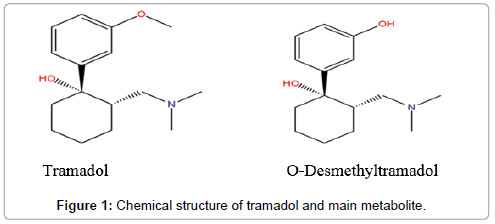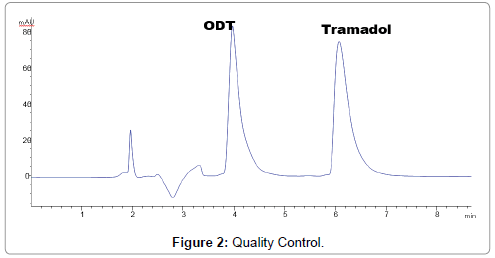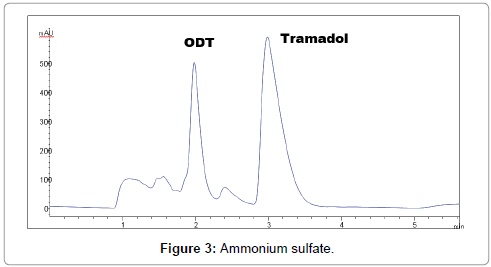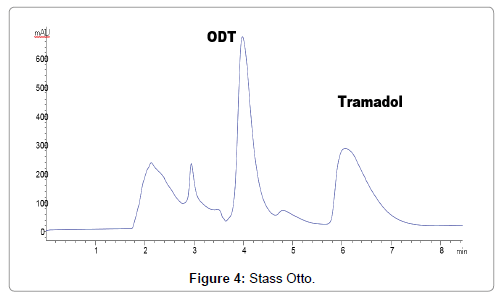Determination of Tramadol in Liver Tissues Using HPLC-DAD
Received: 22-Jan-2018 / Accepted Date: 09-Feb-2018 / Published Date: 13-Feb-2018 DOI: 10.4172/2155-9872.1000397
Abstract
Tramadol prescribed narcotic analgesic; tramadol overdose was reported old male 35 years. Free tramadol and its metabolite isolated by two methods of extraction, Stas Otto and ammonium sulfate extraction from liver tissues and comparison between efficiency of the two methods. Liver extractions have tramadol and main metabolite O-desmethyltramadol was quantified by HPLC-DAD. Tramadol was determined in liver concentration 27.98 μg/g and 27.93 O-desmethyltramadol in Stas Otto. Liver concentration of tramadol 23.92 μg/g and O-desmethyltramadol 9.62 μg/g in ammonium sulfate extraction. Objective: To determination free tramadol and its metabolite in liver tissues by using two methods of extraction and comparison concentrations by HPLC-DAD of liver old male 35 years over dose in Upper Egypt.
Keywords: Tramadol; Metabolite; Tissues; HPLC-DAD
Introduction
Tramadol consists of two enantiomers (+) –, and chemically (+)-trans-2-(Dimethylaminomethyl)-1-(m-methoxyphenyl) cyclohexanol, was first synthesized in 1962 by Grünenthal GmbH in Germany. Tramadol is rapidly and almost completely absorbed after oral or parenteral administration. The main tramadol metabolic reactions are N- and O-demethylation and conjugation with glucuronic acid and sulfate. The major metabolites formed are O-monodesmethyltramadol, N,O-didesmethyltramadol and their conjugates, and N-monodesmethyltramadol. O-Monodesmethyltramadol is an active metabolite and has a greater analgesic activity than the parent drug.
Tramadol analgesic effects are due to the inhibition of norepinephrine and serotonin reuptake as well as agonism of mu receptors which cause blockage of the pain impulses in the spinal cord while its metabolite O-desmethyltramadol acts on the μ-opioid receptor.
a) Affecting mu receptors causing the opioid-like effects;
b) Affecting noradrenergic pathways causing inhibition of norepinephrine reuptake in Central Nervous System (CNS);
c) Affecting serotonergic pathways causing inhibition of serotonin reuptake in the CNS;
d) Affecting GABAergic pathways causing increased GABA neurotransmitter in the brain [1-6].
The relation between serum level and analgesic effect is not the same among different people. It is estimated that the normal therapeutic serum level of tramadol and its metabolite are 0.1 to 0.3 mg/L and 0.03 to 0.04 mg/L, respectively [7-10]. It is advised that the drug be used with caution in those with liver or kidney failure, due to metabolism in the liver (to desmetramadol) and elimination via the kidneys [11].
Symptoms of tramadol intoxication are similar to those of other opioid analgesics but may include serotonergic and noradrenergic components. Symptoms include central nervous system (CNS) depression and coma, tachycardia, cardiovascular collapse, seizures, and respiratory depression up to respiratory arrest.
In overdose, lethargy, nausea, tachycardia, agitation, seizure, coma, hypotension, hypertension, respiratory depression, dysuria, constipation, dizziness, facial paresthesia, ataxia, headache, edema, movement disorders, perspiration, blurred vision, hallucination, itching, vertigo, palpitation, hypo- and hyper-reflexia, diplopia, multiorgan failure, acute liver failure due to fulminant liver necrosis, renal failure, and urine retention have been reported [12-16].
O-desmethyltramadol impairs consciousness and causes electrocardiographic (ECG) changes and seizure Seizure is more common in young males (mean age of 22-39.5 yrs.), however, some studies reported no significant difference in the frequency of seizure between different genders [17]. The most common mechanisms of death after tramadol overdose are cardio-respiratory depression, resistant shock, asystole, and liver failure [18]. Apnea may increase the risk of tramadol intoxication-related deaths [19].
Materials and Methods
Instrumentation: HPLC-DAD, Column: ZORBAX SB-C8, Wave length: 218, Flow Rate: 1 ml/min, Condition: 50:50 (ACN:Phosphate buffer: (pH 5.5).
Reagents:
1. Stas Otto extraction: ethyl alcohol, acetone and tartaric acid.
2. Ammonium phosphate extraction: saturated ammonium phosphate.
The extractions converted to alkaline by ammonia and chloroform solvent was used.
Discussion
Tramadol is available as tablets, solution for injection, and suppository. Tramadol is the first distribution drug abuse in Egypt.
A fatal overdose case involving tramadol, all body tissues and blood, the drug concentration was greater than the metabolites N-desmethyl and O-desmethyltramadol, and O-desmethyltramadol was always greater concentration than the N-desmethyl metabolite [20].
Tramadol is extensively metabolized in the liver by demethylation, oxidation and conjugation (sulphation and glucuronidation). Tramadol is considered to be a safe drug so, most of the studies were performed according to the GLP guidelines on the basis of the guidelines on the quality, safety and efficacy of tramadol for human use of the commission of the European Communities (EC Guidelines).
However, mortality has been reported old male 35 years in Upper Egypt, his family mentioned that' he was orally unknown materials and dead at reached to emergency of hospital. Autopsy didn't find any signs and lab investigations of pesticides and insecticides and another routine work of toxic compounds it's negative results and other work of drugs except tramadol drug only by high concentrations was determined (over dose). Tramadol and its metabolite O-desmethyltramadol were determined in over dose by two famous methods of extractions and comparison between its Stas-Otto and ammonium sulfate are used to remove fatty components, impurities and other interference materials and precipitate proteins.
The results reported over dose in Table 1 explain the same and Stas-Otto had higher extraction efficiency of tramadol and Odesmethyltramadol more than in ammonium sulfate extraction in tramadol and metabolite's, hence Stas-Otto is preferred (Figures 1-4).
| Extraction | ODT concentration | Tramadol concentration |
|---|---|---|
| Ammonium sulfate | 23.92 µg/g | 9.62 µg/g |
| Stass Otto | 27.98 µg/g | 27.93 µg/g |
Table 1: Concentrations of tramadol and O-desmethyltramadol in Stass Otto and Ammonium sulfate.
Conclusion
Physicians and experts in branches of medicine must be aware peoples from tramadol addiction and over dose of tramadol, the governments must be but control in used this compound and fights distribution between youth.
References
- Shamsi Meymandi M, Nakhaee N, Shojaee Baghini M, Mazhari S, Sharifi S, et al. (2005) Evaluation of general practitioners knowledge about Tramadol, Kerman. Journal of Kerman University of Medical Sciences 12: 202-208.
- Shadnia S, Soltaninejad K, Heydari K, Sasanian G, Abdollahi M (2008) Tramadol intoxication: a review of 114 cases. Human & Experimental Toxicology 27: 201-205.
- Raffa R (2006) Pharmacological aspects of successful long-term analgesia. Clinical Rheumatology 25: 9-15.
- Matthiesen T, Wöhrmann T, Coogan T, Uragg H (1998) The experimental toxicology of tramadol: an overview. Toxicology Letters 95: 63-71.
- Eizadi-Mood N, Sabzghabaee AM, Safdari A, Yaraghi A (2011) Clinical Signs, Hospitalization Duration and Outcome of Tramadol Intoxication. Journal of Isfahan Medical School 28: 1187-1193.
- Senay EC, Adams EH, Geller A, Inciardi JA, Muñoz A, et al. (2003) Physical dependence on Ultram (tramadol hydrochloride): both opioid-like and atypical withdrawal symptoms occur. Drug and Alcohol Dependence 69: 233-241.
- Taghaddosinejad F, Mehrpour O, Afshari R, Seghatoleslami A, Abdollahi M, et al. (2011) Factors related to seizure in tramadol poisoning and its blood concentration. Journal of Medical Toxicology 7: 183-188.
- Liang M, Cai X, Jin M (2010) Distribution of tramadol in acute poisoned rats. Fa Yi Xue Zazhi 26: 436-439.
- Clarot F, Goulle J, Vaz E, Proust B (2003) Fatal overdoses of tramadol: is benzodiazepine a risk factor of lethality. Forensic Science International 134: 57-61.
- Radbruch L, Glaeske G, Grond S, Munchberg F, Scherbaum N, et al. (2013) Topical review on the abuse and misuse potential of tramadol and tilidine in Germany. Subst Abus 34: 313-320.
- Rossi S (2013) Australian Medicines Handbook. Adelaide. The Australian Medicines Handbook Unit Trust.
- Jovanovic-Cupic V, Martinovic Z, Nešic N (2006) Seizures associated with intoxication and abuse of tramadol. Clinical Toxicology 44: 143-146.
- Mansouripour SM, Afshari R (2013) Chlordiazepoxide preventive effect on tramadol overdose induced serotonin syndrome evaluated by Hunter and Radomski criteria: A clinical trial. Toxicology International 20: 126.
- Bianchetti M, Beutler A, Ferrier P (1988) Acute poisoning with a narcotic (Tramadol) in an infant of five weeks. Helvetica Paediatrica Acta 43: 241-244.
- Agrawal A, Diwan S, Mahajan R (2009) Severe delirium following single dose of tramadol. Indian Journal of Medical Sciences 63: 80-81.
- Lofwall MR, Babalonis S, Nuzzo PA, Siegel A, Campbell C, et al. (2013) Efficacy of extended- release tramadol for treatment of prescription opioid withdrawal: a two-phase randomized controlled trial. Drug Alcohol Depend 133: 188-197.
- Tashakori A, Afshari R (2010) Tramadol overdose as a cause of serotonin syndrome: a case series. Clinical Toxicology 48: 337-341.
- Sharawy NE (2012) Toxicity of Tramadol. Protocol Submitted for Fulfilment of Master’s Degree in Forensic Medicine and Clinical Toxicology, Faculty of Medicine, Benha University.
- Hassanian-Moghaddam H, Farajidana H, Sarjami S, Owliaey H (2013) Tramadol-induced apnea. The American Journal of Emergency Medicine 31: 26-31.
- Moore KA, Cina SJ, Jones R, Selby DM, Levine B, et al. (1999) Tissue distribution of tramadol and metabolites in an overdose fatality. Am J Forensic Med Pathol 20: 98-100.
Citation: Shihata MAA (2018) Determination of Tramadol in Liver Tissues Using HPLC-DAD. J Anal Bioanal Tech 9: 397. DOI: 10.4172/2155-9872.1000397
Copyright: © 2018 Shihata MAA. This is an open-access article distributed under the terms of the Creative Commons Attribution License, which permits unrestricted use, distribution, and reproduction in any medium, provided the original author and source are credited.
Share This Article
Open Access Journals
Article Tools
Article Usage
- Total views: 4823
- [From(publication date): 0-2018 - Apr 03, 2025]
- Breakdown by view type
- HTML page views: 3940
- PDF downloads: 883




